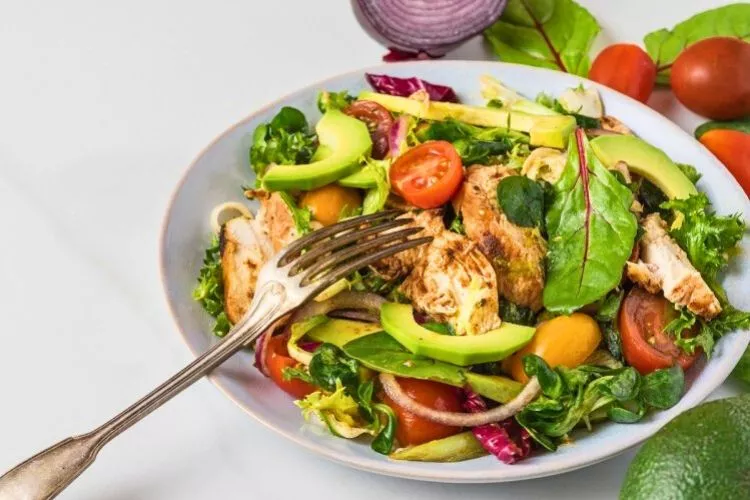In today’s uncertain world, being prepared for unforeseen circumstances is essential.
One such scenario, a potential doomsday event, raises the critical question: how much food do you need to survive?
While it may seem daunting to calculate the appropriate amount, understanding your body’s nutritional requirements is crucial. In this article, we will:
- Evaluate the daily calorie and nutrient needs of an average person,
- Explore the differences in requirements based on age, gender, and activity level,
- Discuss the shelf-life and storage of various food items, and
- Provide practical tips to build a balanced and sustainable food supply for long-term survival.

By the end of this article, you’ll be equipped with the essential knowledge to prepare yourself and your loved ones for the unexpected.
how much food do you need to survive?
The calorie count can vary according to age, gender, and physical activity level. A balanced diet containing proteins, fats, carbohydrates, and a mix of vitamins and minerals is crucial.
During survival, shelf-stable foods with long expiry dates such as grains, canned goods, and dried foods are recommended. The key is to maintain variety in your diet to meet different nutritional needs, and don’t forget to include a clean water source in your survival planning as well.
Evaluating Daily Calorie and Nutrient Needs
The body requires energy to function from the food we consume. The average adult needs around 2000 to 2500 calories per day. However, this can change based on physical activity.

But survival isn’t just about calorie count. Consume a diverse range of foods to meet your daily nutritional needs. This includes protein, fat, carbs, vitamins, and minerals.
The amount required depends on your gender, age, and physical health but maintaining a balanced diet is significant for survival.
Understanding Nutritional Requirements Based on Age, Gender and Activity Level
The dietary needs of individuals differ according to multiple factors:
- Children and adolescents: Younger individuals require higher nutrient intake than their size during growth and development. Boys aged 9-13 need about 1800-2600 calories, while girls of the same age range require 1400-2200 calories. As they reach adolescence (14-18 years), boys need around 2200-3200 calories, and girls require 1600-2400 calories.
- Adults: Generally, men require more calories than women because they have a higher proportion of muscle mass. For men aged 19-30, recommended calorie intake is 2400-3000, whereas, for women in the same age group, it’s 1800-2400. In the 31-50 age range, men need about 2200-3000 calories, while women require 1800-2200 calories.
- Elderly: Calorie requirements don’t see a significant spike in older adults. However, they may need more of certain nutrients, like Vitamin D and B12, due to decreased synthesis and absorption in the body. To maintain muscle mass and strength, older adults should also prioritize protein intake.
- Pregnant and nursing mothers: Pregnant women should consume an additional 300-500 calories daily to support fetal growth and lactation.
- Physical activity: Sedentary individuals require fewer calories than their more active counterparts. Moderately active people need 200-400 additional calories, while highly active individuals require an extra 400-600 calories to fuel their bodies efficiently.
It’s crucial to tailor your diet and caloric intake to your needs, considering all these factors to ensure proper nourishment and overall well-being.
Discussing the Shelf-life and Storage of Various Food Items
When preparing for long-term survival scenarios, consider the shelf-life and storage requirements of your chosen food items:
- Dry goods: Grains (e.g., rice, quinoa), pasta, cereals, and beans can last years if properly stored in a cool, dry, and dark environment. Airtight containers or vacuum-sealed bags can help to prevent spoilage and pests. Flour, however, has a shorter shelf life of about 6-12 months due to its higher oil content.
- Canned goods: Goods like fruits, vegetables, dairy products, soups, seafood, and meats can last several years due to the sterilization process involved in canning. Pay attention to “best by” dates and the physical condition of the cans (e.g., avoid dented or bulging cans). Store cans in a cool, dry, dark places to maximize shelf life.
- Preserved foods: Foods preserved in sugar, salt, or vinegar have a long shelf life. Examples include jams, fruit preserves, pickles, dried fruits or meats like jerky. Store these items in a cool, dry, dark area, and ensure they are adequately sealed to maintain freshness.
- Freeze-dried and dehydrated foods: These options, such as powdered milk, freeze-dried fruits, vegetables, and meats, can have an extended shelf life of up to 25 years if kept sealed and stored properly. They are also lightweight and easy to carry, making them an excellent choice for emergency preparedness.
- High-calorie survival foods: Items like energy bars, MREs (meals ready to eat), and calorie-dense emergency food rations have a long shelf life and provide vital calories to sustain energy levels during survival situations.
- Seeds and nuts: These can be excellent sources ofenergy, fiber, and healthy fats. Store them in a cool, dry, dark place to prolong freshness. Some seeds can also be used for sprouting or growing your food if the situation demands it.
Proper storage is crucial to ensure the shelf-life and quality of your food supplies. Invest in durable, food-grade, and pest-resistant containers, and develop an organized food storage system to keep track of your perishable and non-perishable items.
Practical Tips for Building a Balanced & Sustainable Food Supply
- Think in variety: Cultivating a diverse stockpile can help you receive a balanced mix of nutrients. This includes proteins (canned meats, beans, nuts), carbohydrates (rice, pasta, cereals), and fats (oils, nuts). Also include different vitamins and minerals through various canned fruits and vegetables. Incorporate comfort foods (like chocolate or cookies) for morale and energy boosts.
- Go for non-perishable items: Invest in foods with a long shelf-life that are easy to store. Things such as canned goods (meats, vegetables, fruit), dried foods (fruits, jerky), and whole grains (rice, oats) are perfect for long-term storage. Consider also including dehydrated or freeze-dried meals, which only require water to prepare.
- Don’t forget water: A critical part of survival planning, humans can survive far longer without food than water. Aim for one gallon of water per person daily, accounting for both drinking and sanitation. Store in food-grade water storage containers and consider options for water purification like tablets or filters.
- Label & rotate: Date all food and water containers upon purchase, and use the ‘first in, first out’ method to ensure you consume your food before it expires. Keep an organized inventory of your supplies to manage usage and identify when certain items need replenishment.
- Consider special dietary needs: In a survival situation, pay attention to any food allergies, intolerances or dietary restrictions your group may have. Stock non-dairy alternatives for lactose intolerant individuals, or gluten-free options for those with a gluten sensitivity.
- Include a manual can opener and cooking utensils: Your stockpile should also include the necessary tools to prepare and consume your meals, particularly if you rely heavily on canned goods.
Building a balanced and sustainable food supply takes time and careful planning, but it elevates your chance of survival and maximizes overall health during challenging circumstances.
Average food consumption per person per day in kg
Based on the data, an average person globally consumes about 1.85 kg of food daily. However, it’s crucial to note that this figure might change with various factors such as the individual’s age, sex, health condition, job nature, and physical activities.

When one speaks particularly of calorie intake, the data varies from country to country.
So, while 1.85 kg is the average daily food consumption in terms of weight, the nutritional and caloric distribution within that can vary significantly based on numerous factors.
Frequently Asked Questions (FAQs)
How much food is enough to keep you alive?
To stay alive, the average person needs at least 1,200 calories per day for women and 1,500 calories per day for men. These calorie counts vary with age, weight, and activity level but represent the minimum needed for basic bodily functions and survival.
How much food should I prepare for survival?
To prepare for survival, plan for at least 2,000-2,500 calories per person daily, including a mix of carbohydrates, proteins, fats, vitamins, and minerals. Consider a stockpile lasting 72 hours for short-term emergencies or up to two weeks or longer for extended situations.
Can you live off 500 calories a day?
Surviving on 500 calories a day is not sustainable in the long term, as it doesn’t meet minimum daily nutritional needs. This calorie deficit can lead to serious health issues like muscle loss, weakened immunity, and organ damage.
What 3 foods can you survive on?
While no three foods alone can provide all the nutrients required for survival, a combination of potatoes, legumes (beans, lentils, chickpeas), and fortified cereals can provide a substantial range of carbohydrates, proteins, fats, and essential vitamins and minerals.
How little can a person eat and survive?
A person’s minimal caloric intake varies based on weight, height, age, and activity level. However, consuming fewer than 1,200 calories per day for women and 1,500 calories per day for men can lead to malnutrition and serious health issues.
Can you survive on 50 calories a day?
No, you cannot survive on 50 calories a day. This extremely low caloric intake would lead to rapid weight loss, malnutrition, muscle wasting, organ damage, and death.
Conclusion:
The food required for survival varies based on many factors, including age, gender, weight, height, and activity level.
However, on average, an individual requires a minimum of 1,200 to 1,500 calories per day for bare survival, with an optimal range of 2,000 to 2,500 calories for maintaining health and function.
Choosing a diverse range of foods contributes to nutritionally balanced meals, supplying the body with essential macronutrients and micronutrients necessary for optimal health.
It’s critical to remember that while survival is possible on minimal food and calorie intake, the goal is to thrive, not merely survive. Effective planning and nutritionally balanced food choices can help ensure survival and health in challenging situations.


